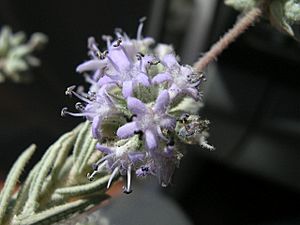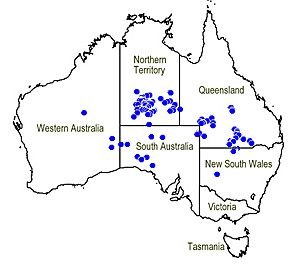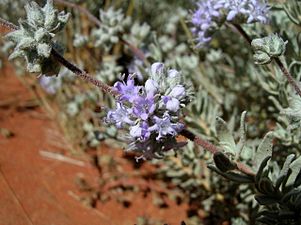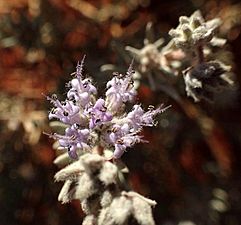Dicrastylis lewellinii facts for kids
Quick facts for kids Dicrastylis lewellinii |
|
|---|---|
 |
|
| Scientific classification | |
 |
|
| Synonyms | |
|
Chloanthes lewellinii F.Muell. |
Dicrastylis lewellinii is a type of flowering plant. It belongs to the Dicrastylis group of plants. This plant is part of the Lamiaceae family. You can find it in many parts of Australia. These include Western Australia, the Northern Territory, New South Wales, Queensland, and South Australia.
Contents
What Does Dicrastylis lewellinii Look Like?
This plant is a shrub. It usually grows up to 1 meter (about 3 feet) tall. You can often find it growing in red sand. It likes sandy places like sand dunes.
Stems and Leaves
Its stems are round. They do not have any special scales. The leaves grow in pairs on opposite sides of the stem. They are 10 to 15 millimeters long. They are also 1 to 2.2 millimeters wide. The leaves have special branched hairs. These hairs look a bit like tiny trees.
Flowers
The plant has small leaf-like parts called bracts. These bracts are 3.5 to 7.5 millimeters long. The flowers grow directly on the stem. They do not have a stalk. The outer part of the flower is called the calyx. It has five parts, each 2.5 to 3 millimeters long. These parts are also covered in branched hairs.
The colorful part of the flower is called the corolla. It can be mauve, purple, lilac, or violet. The corolla is 4 to 9 millimeters long. It does not have any dots or stripes inside. Each flower has five stamens. These are the parts that make pollen. This plant usually blooms in spring and summer.
Where Does Dicrastylis lewellinii Live?
In New South Wales, you can find this plant in dry and partly dry areas. It grows in sandy soils. It is often found in areas with spinifex grasses. It also grows in low shrublands.
How Was Dicrastylis lewellinii Named?
The plant was first described in 1873. A scientist named Ferdinand von Mueller gave it the name Chloanthes lewellinii. Later, in 1880, he looked at it again. He then decided to rename it Dicrastylis lewellinii.
Gallery




